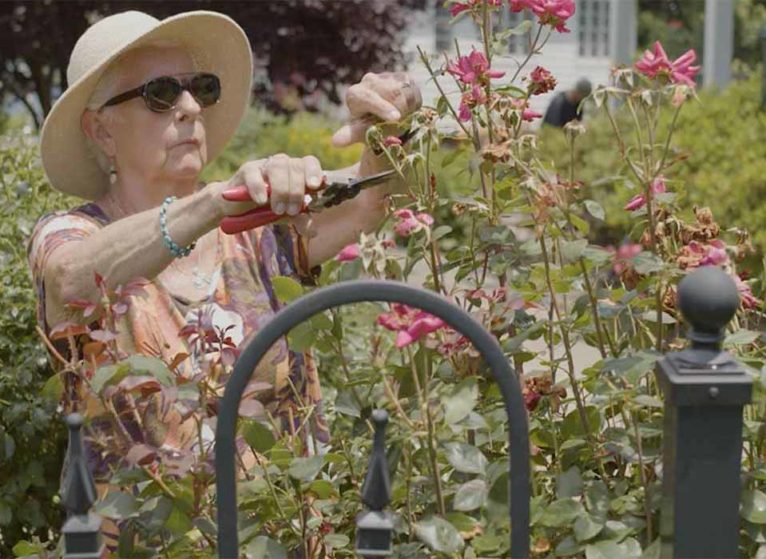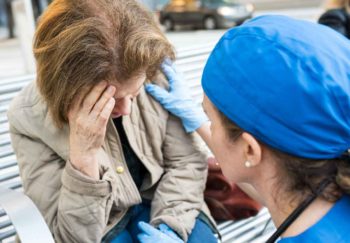Bobbye Cohen lived with a small, unruptured brain aneurysm for years. It was discovered after she was checked for a heart health scare. Doctors kept an eye on it, which is common with small aneurysms. “We knew that if I ever said that I had the worst headache of my life, it was a 911 call,” Bobbye recalls.
After 9 years, that headache came. Her aneurysm, although still small, ruptured. Mike Cohen, Bobbye’s husband, recounts: “I got her to UVA Health, where they started treating her immediately.”
Aneurysms Can Lead to an Emergency
Luckily, a UVA Health team was able to quickly get Bobbye help. “She had suffered a ruptured brain aneurysm, and this was complicated by the fact that she also suffered a pretty significant cardiac injury,” says Ryan T. Kellogg, MD, a neurosurgeon and brain aneurysm specialist at UVA Health. Kellogg and his team helped Bobbye survive her aneurysm rupture. “When Bobbye initially arrived, she was neurologically very unstable. She was in a deep coma.”
What Is a Brain Aneurysm?
A brain aneurysm is a balloon-like bulge in a blood vessel in the brain. As long as aneurysms stay small and don’t leak or break (called a rupture), they usually don’t cause any symptoms. You likely wouldn’t know you have an unruptured brain aneurysm until it’s found during a medical test for something else, like Bobbye did.
“Bobbye's is actually a pretty common scenario,” says Kellogg. “Monitoring small aneurysms is something we do frequently, because if they do start to change size or shape, then we start to have a more serious conversation about whether that should be treated.”
Surviving a Brain Aneurysm Rupture
Concerned About Brain Aneurysms?
If you think someone is having a brain aneurysm or stroke, call 911 right away. Talk to a UVA Health primary care doctor about your stroke or aneurysm risk.
When an aneurysm does rupture, that’s an emergency. It can cause a type of stroke. If you think someone has a brain aneurysm rupture or a stroke, it’s important to get them to a hospital right away.
If you see someone with these symptoms, call 911:
- Sudden severe headache (“worst headache in my life”)
- Vomiting
- Neck stiffness
- Confusion
- Loss of consciousness
- Trouble with vision
If you suspect someone is having a stroke, remember BE FAST:
- Balance — sudden loss of balance or coordination
- Eyes — double vision or lack of vision in one eye
- Face — an uneven smile, one side of the face drooping
- Arm — one arm is weak
- Speech — slurred or abnormal speech
- Time — call 911 at once
See Bobbye tell her story of surviving a brain aneurysm rupture thanks to Mike's quick action and the care she received at UVA Health.
BOBBYE COHEN: I met my husband Michael Cohen, playing city league volleyball almost 40 years ago. In 2013, I experienced a high blood pressure incident, which took me to the emergency room. It was discovered that I had a very, very small aneurysm. In November of 2021, my annual MRI showed a very slight change. I experienced a severe headache.
MIKE COHEN: And Bobbye said she didn't feel good, and I grabbed her as she sort of went unconscious.
BOBBYE COHEN: We knew that if I ever said that I had the worst headache of my life, it was a 911 call. We were aware of the cons⦠of what would happen if my aneurysm did rupture.
MIKE COHEN: I got her to UVA, where they started treating her immediately.
RYAN KELLOGG: When Bobbye initially arrived, um, she was neurologically very unstable. She was in a deep coma.
MIKE COHEN: Prognosis was well, it was terrible. I went home and told my daughter that it was very possible that Bobbye would not be surviving this aneurysm.
RYAN KELLOGG: Perhaps the biggest challenge with treating her is just how to manage the aneurysm initially. There's two kinds of mainstay therapies for ruptured aneurysms: One is an open craniotomy where we remove part of the skull. The other option is to treat it endovascular. Well, where we go in through an artery with a small catheter or tube, get into the aneurysm and then seal it off from the inside. So Bobbye underwent endovascular coiling of her rupturing aneurysm and navigating a small catheter and a wire into the aneurysm, and then blocking off the blood flow into the aneurysm the inside. This was successful as we were able to get coils into the aneurysm, which then creates clot and seals the aneurysm off to prevent it from re-rupturing.
BOBBYE COHEN: I was admitted to the NNICU, which is a Neurointensive care unit where I remained a patient for six weeks.
RYAN KELLOGG: My first interaction with Bobbye's husband, Mike, I had met him in the intensive care unit or bedside, and at that point, he rightfully so, had a number of fears about her condition. So we took the time to discuss the general history of what happens with patients that suffer ruptured aneurysms, what to expect in their recovery and care. And probably most importantly, to understand that there are often times number of hiccups outside of just the brain function that have to be overcome in the course of care. And given the shape and size aneurysm, it certainly presented a challenge. But ultimately, I think we made the correct decision in her management.
MIKE COHEN: Just a terrific doctor and also a skilled technician because in the middle of her procedure, he knew I was very fearful when they were repairing her aneurysm. He had them call me during the operation and give me a heads up that things were going very well, better than he expected. He came to see Bobbye after her recovery and there was as good as he could expect, and there was no further damage. So it was a win.
BOBBYE COHEN: All I wanted to do was come back whole. I think I came back better than whole. I was encouraged physically and emotionally. My spiritual path was encouraged and lightened because of all the people that were caring for me.
MIKE COHEN: I mean, I love Bobbye more than I did when I saw her on that volleyball court. And I was pretty much in love from first sight. BOBBYE COHEN: A day doesn't go by that I'm not grateful or that I don't think about this experience.


Excellent video of Bobbye’s ordeal with the aneurysm! I know Bobbye from a women’s Bible study at First UMC. We were all praying for her during her hospital stay and so glad when she finally came home. Thank you for the explanation of treating aneurysms. Hearing Bobbye and Mike’s story really underscored how scary an aneurysm can be and the importance of getting to a hospital quickly. So thankful that UVA was able to successfully heal her.